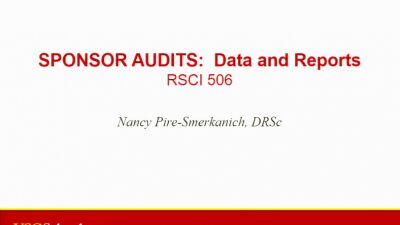- Auditing Personnel
- Auditor should be independent from people directly involved in conduct of studies to ensure there is no bias
- Quality Control (QC) vs. Quality Assurance (QA)
- Quality control includes activities which control the quality of products by finding defects
- Quality assurance is focused on preventing defects
- Data Audits- Data Management Activities
- The purpose of a data audit is to assure confidence in quality and completeness of integrity of data.
- Data audits are conducted before a product is given approval by a regulatory agency to be commercially sold.
- Data management activities include:
- CRF management and tracking
- Data entry
- Data validation
- QC procedures
- Query management
- Database locking
- Transfer of records and files
- Data handling reports.
- Data verification ensures consistency before and after the transformation process.
- An audit plan should address the extent and nature of sampling data.
- Verification activities include ensuring consistency between data on case report forms (CRFs) and databases
- May be good to focus on CRFs that have been queried
- Report Audits- Traceability of Data
- Clinical Study Report (CSR) audit assess whether a report is fair and accurate.
- Adheres to ICH E3 Guidance on Structure and Content of Clinical Study Reports.
- There should be documentation of justifications for deviations from the protocol or any other changes.
- The report conclusions should be an accurate representation of the results.
- The key to a successful data audit is traceability.
- CDISC Standards:
- SDTM- Submission Data Tabulation Model
- ADaM- Analysis Data Model
Regulatory Science Symposium: Monitoring and Auditing Session 4: Sponsor Audits: Data Handling and Reports (2016)
In this series, we will discuss what a sponsor does with data after a clinical trial finishes at a site, focusing on audits.
Assistant Professor, USC Mann Dept. of Regulatory and Quality Sciences; Associate Director, Regulatory Knowledge and Support
Course Syllabus/Topics
Acknowledgement
Accompanying text created by Amelia Spinrad | Regulatory Knowledge Support Specialist | spinrad@usc.edu

